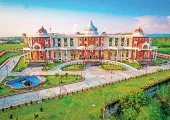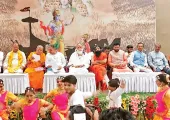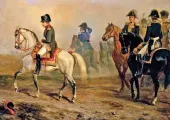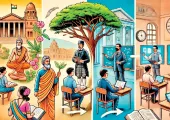Well educated children - best citizens and nationupliftment

Dr. Chandra Bahadur Thapa Finance and Legal
Advisor- Bhartiya Shiksha Board and Legal Advisor to
Patanjali Group
It is said that Lord Macaulay, the originator of the Indian modern education system before NEP-2020, gave some parts of the speech given in the British Parliament on 2 February 1835 - 'I have traveled to every end of India but I have not visited even one Never seen a man who begs or a thief. I have seen immense wealth in this country. Have seen high sublime values. I believe that no one can ever conquer Indians with these merit values, till then; Unless we break the backbone of this country, and the backbone of India is its spiritual and cultural heritage. That's why I propose to change the old education system of India. Change its culture so that every Indian thinks that whoever is foreign is better. They start thinking that English language is great than other native languages. By this they will lose their respect. Will start forgetting their indigenous ethnic traditions and then they will become what we want, really an invaded and defeated nation'.
Through the above speech, in 1835 i.e. 187 years ago, someone challenged to 'break the backbone of the country' and kept on breaking. And we shamelessly did not do anything even after getting so called independence from that regime 75 years ago. By pretending to protest, the elite class of the society remained. Made the English language the language of the High and Supreme Court, and continued to consider English speaking (superior). Keep bowing down before the convent educated. No matter how they show off, and in the last 7-8 years, as an effort to improve oneself, someone has brought 'the concept of modern education inclusive of Indian traditional knowledge', then they are opposing it on various pretexts - some by language, some by other pretexts.

Moreover, the best youths who have studied in prestigious educational institutions run by the country's tax payer money like IIT, IIM, AIIMS etc., are eager to get jobs in the companies of America, Britain, Europe, etc. who made fun of Sanatan. To sell their products in India, these companies appoint these people by paying ten times the salary of the President of India, and we are overwhelmed with pride, doesn't this show the double character of the so-called patriot Indians, especially the Sanatanis?
Characteristics of good education
Nowadays, in the eyes of the world, the main feature of education is considered to be able to do a good job or to earn a living through any other profession considered big. Because it is necessary to read and write in all these works, so nowadays only those people who are successful in these works are considered educated. That's why the crutch of 'coaching' has become mandatory in the process from admission to passing, one who does not go to coaching cannot even dream of being successful in a blind race.
But in Sanatan it has been taught from the very beginning that-
Na Abhisheko Na Sanskarah Singhsya Kiyate Vane I
Vikramarjitstvasya Swayameva Mrigendrata II
Means - Singh (lion) does not need a coronation ceremony to become the king of the jungle, he himself becomes the king by his actions and courage.
Vipatsu Vajradhauryana Samgrame Vajradehinam I
Sangho Sashtravipatkale Sawdajrakavachayate II
Unions are sadvajrakavchayate of national crisis. That is, the one who has the utmost patience in the time of calamity, the one who has a strong body like a thunderbolt on the occasion of war and when the nation is threatened, then only the united power protects the nation by becoming a shield like the perfect thunderbolt.
Amantramaksharam Nasti Nasti Moolamanaushadhama I
Ayogyah Purusho Nasti, Yojakastatra Durlabhah II
That is, there is no letter that cannot be used to make a mantra. There is no plant from which medicine cannot be made. No person is useless, only the adder (knowing the use) is needed.
The story of the Mahabharata is that Dharmaraja disguised as a yaksha asked Yudhisthira, 'What is the path?' (Which path is sufficient?) On this, Yudhisthiraji
The answer was-
Tarkoapratishthah Shrutayo Vibhinna Naiko Rishiryasya Matam Pramanam I
Dharmasya Tatvam Nihitam Guhayam Mahajano Yen Gatah Sah Panthah II
Means - there is no well established logic to determine the real way of living life, Shrutis (Veda-Shastras) also talk in different ways. There is no sage/thinker whose words can be called proof. In fact, the meaning of religion is hidden in the Guha (cave), that is, it is very mysterious. In such a situation, the path which the best person in the society adopts, that path is exemplary.
Depending on the country, time and character, sometimes what we consider unrighteous is actually religion and what we think is religion, is unrighteous. Saying a great person does not mean that one who has earned a lot of wealth, or who is endowed with a high position and many rights. The best is the one who is characterful, dutiful, sensitive towards others, towards the interests of the country and society be dedicated and above all be self-aware, enlightened person, he sees Brahman in every living being. That's why they do not harm anyone, rather they are imbued with the spirit of charity. The life of such a person is full of greatness. Verse 18 of Pujyapad Adishankaracharya 'Brahmagyanavalimala' said:
Brahma Satyam Jaganmithya Jivo Brahmaiva Naparah I
Anenam Vedyam Sachchhastram Iti Vedantadindimah II
It means : Brahman is truth, the universe is false, and the living entity is Brahman, and there is no other. This is the true scripture that can be known, says Vedanta declaration.
In the 187th chapter of Shantiparva of Mahabharat , Shloka 14, it has been described as follows:
Atma Kshetragya Ityuktah Sanyuktah Prakritairgunaih I
Taireva Tu Vinirmuktah Parmatmetyudahyatah II
That is - when the soul is bound in nature or in the world, then it is called Kshetragya or Jivatma and when it is free from the modes of nature it is called Paramatma.
Shubham Karoti Kalyanamarogyam Dhansampada I
Shatrubuddhivinashaya Deepajyotirnamoastute II
Meaning - I bow down to the light of the lamp, which does good, welfare, maintains health, wealth and destroys the enemy's intelligence.
Yatra Naryastu Poojyante Ramante Tatra Devatah I
Yatraitastu Na Pujayante Sarvastatraphalah Kriyah II Manusmriti 3/56 ||
Means - where women are worshipped, gods reside there. And where women are not worshipped, they are not respected, all the good deeds done there become fruitless. This is an accurate review - with daughter-in-law, daughters and all the women of the family about the unpleasant consequences of disrespectful contemptible behavior! The houses that the wives of the wives swear by are not worshiped in return.
Jamayo Yani Gehani Shapantyapratipoojitah I
Tani Krityahataneeva Vinashyanti Samantatah II Manusmriti 3/58
That is: Houses in which daughters-in-law and family women curse because of disrespect and contempt, that is, feelings of destruction of the family arise in their minds, become destroyed by sudden acts.
Tools of Education and Reasons for India's Backwardness
According to Vedic theory, the creation of the universe and the creation of living beings took place by the will of the Supreme Lord. After this (the sound) appeared. Words are made from sounds (letters) and letters. The sum of words was called (sentence). After this, thoughts, feelings, opinions and information started being exchanged from father to son and from teacher to disciple. Indian sages named the process of listening as Shruti and the process of understanding as Smriti. This method of dissemination of knowledge was unlimited and unsafe, due to which man felt the need to record the best thoughts, opinions and information of his ancestors and teachers. For this, he invented the script and started writing by digging on the barks of stones and trees. Even with this technique, it was not possible to preserve the thoughts for a long time. After this, the process of writing on palm leaves and bhojpatra started by peeling the wood with a sharp point. Many books of ancient times have been found written on Bhojpatra.
The equipment of modern education, especially paper and printing, arrived relatively late in India. According to historians, paper was first invented in China. 201 BC During the Han Dynasty, Tsai-Lun, a resident of China, invented paper. Before this invention, writing was done on bamboo and on silk cloth. Silk was very expensive and bamboo was very heavy so 'Tsai Lun' thought of making something that was lighter and cheaper. Then he manufactured paper from hemp, mulberry leaves, tree bark and other types of fibers. After that paper started being used all over the world. Some historians are of the opinion that the first use of paper was in Egypt. It was paper made from a grass called papyrus anticorium, which was called papyrus or papyri. It is known from the book 'Acousods' by the writer 'Nash' that papyri were made in Egypt about fourteen hundred years before Christ. Then to Rome people made papyri.
Paper was first manufactured and used in India during the Indus Civilization. Later on, the first paper making factory in India was set up by 'Sultan Zainul Abidin' (1417-1467 AD) in Kashmir. The first paper factory based on modern technology was set up on the banks of the Hooghly River in 1870 at a place called 'Bali' near Calcutta. After this paper factories were set up in Titagarh (1882), Bengal (1887), Jagadhri (1925), Gujarat (1933) etc. Printing generally refers to printing, which can be done on paper, cloth, plastic, gunny etc. Stamping on envelopes, postcards and registered letters in post offices is also called (printing). In the early era, printing was an art, but in the modern era, it has become completely technical based. The art of printing has blossomed, flourished, developed and changed in the form of technology in the field of journalism.
In 105 AD, Chinese citizen Tus-Tsai Lun made paper with the help of cotton and muslin. In 712 AD, precise and precise block printing started in China with the help of wooden blocks. In China itself, in 650 AD, the world's first printed book named Diamond Sutra was published. In 1041 AD, a person named Pai Sheng of China prepared letters with the help of porcelain. These letters can be considered as the prototype of modern types. The world's first printing was established in China, in which wooden types were used. Printing was done by applying ink-like material on the types and pressing it on the paper.
Whether this art went to Europe from China or developed independently there is no official explanation available. According to an estimate, the art of making paper would have reached Arab countries from China and from there to Europe. According to another estimate, the art of printing developed independently in Europe during the 14th-15th centuries. At that time there were big painters in Europe. Making independent copies of his paintings was a difficult task. This could not be done quickly. Therefore, stamps were made by engraving pictures on wooden or metal sheets, on which copies of their pictures were prepared by pressing the stamp between two planks in the aforesaid manner by applying ink. The task of printing such letters was not easy. It was a very difficult task to engrave the letters and prepare their impressions. There was a lot of expenditure in that too. still the print is not good. These inconveniences inspired Lawrence Janszon of Germany to create a free type. These types were first used in Europe in 1400 AD.
In 1440 AD, John Gutenberg of Germany invented such types, which could print a large number of different materials in turn. These types of types are called characters of repeatable print. As a result, the majority of the public got the facility to reach news and opinions without any hindrance. The responsibility of being equally ready to maintain this facility fell on the writers and journalists. It was John Gutenberg who set up the world's first printing press in 1454-55 AD. And in 1456 AD, after publishing 300 copies of the Bible, sent it to Paris. The printing date of this book has been fixed as 14 August 1456. John Gutenberg's printing press could produce 600 copies at a time. As a result, within 50-60 years about two crore books were printed in Europe.
Thus, the art of printing started from Germany and spread to European countries. Kolne, Agajvarg Besah, Tome, Paris, Antwerp, Paris etc. became major centers of printing. In 1475 AD, due to the efforts of Sir William Caxton, Britain's first press was established. Due to political and religious unrest in Britain, printing facilities were under government control. To establish it independently, it was a very difficult task to get proper permission from the government. It started in Portugal in 1544 AD.
It is clear from the investigation of the history of printing that the development of the printing press happened in the era of religious revolution. After getting this facility, religious books started reaching the common people very easily. These religious texts being published after translating them into the languages of different countries engaged. Printing technology was introduced in 1556 for Portuguese propaganda brought to Goa in AD and began to publish scriptures. A copy of the Bible book published in Goa in 1561 AD preserved in the New York Library.
Encouraged by this, the Indians also showed the courage to publish their scriptures. Bhimji Parekh was the first Indian who started the press as an industry in Diu in 1670 AD.
In 1638 AD, Pastor Jesse Gloverle left for the United States by loading a printing press in a ship, but due to his death on the way, his associates Massieu and Retefen de established the said printing press. Iron press was invented in 1798, in which a lever there was a facility to publish a large number of copies by Around the year 1811 AD, the power of steam was used to run the circular cylinder, which is now called the rotary press. However, its complete development took place around 1848 AD. By the end of the 19th century, power-driven presses came into use, which made it possible to publish 96,000 copies of 12 pages of The New York Times in one hour. Linotype was invented in 1890 AD, which had the facility of setting letters like a typewriter machine. By the year 1890, colorful block newspapers started being printed in many countries including America. By 1900 AD, illustrated newspapers started reaching the readers due to the facility of electricity operated rotary press, facility of linotype and printing of color pictures, arrangement of printing photography.
By Shruti and Smriti, the heritage of today's so-called science like its ancient literature, history, arms-arts, economics, political science, astronomy-astrology, mathematics, medicine, India lagged behind for a long time in paper and printing and Extremist priests of Islam and Christian cult preachers who were established with the title of Khalifa, Pope and below them Mullah, Maulana, Cardinal, Archbishop, Bishop, Father, Badr etc. The example of the level of planning used to destroy Sanatan with the help of the government is in the so-called speech of Lord Macaulay quoted in the beginning.
The archaic education system reached an abyss in India from eleventh century onwards due to Islamic invasion and encroachment in education system and governance and destruction of scriptures, libraries, temples along with education centers, British rule from seventeenth century Lord Macaulay charter of 1835 till 1947 . The right stone left unturned, the compulsory use of Sanskrit and Hindi and anti-Sanatan education policy of 5 staunch Islamic education ministers from 1947 to 1977 and undeclared use of English in higher courts and Urdu in lower courts almost destroyed India's ancient Sanatan creations . Then the insult of Sanatan Gods and Goddesses in cinema and anti-Sanatan system of ethics in the society started being considered as symbols of modernity, which continues to be updated.
In this way, the sense of insecurity arising from the adverse treatment of the governance system on the Sanatanis and the servile attitude of considering the government job as a glory, confined Sanatani Sanskar to the home or temple or to the community, in the children and parents, family tradition, Gurukul, even in the 20th century. come to the end of increased hatred towards government school and increased attraction towards coaching, short notes, convents. Gradually corruption also increased unimaginably. The propaganda of the heretics and the selective presentation of history created incidents and situations in the Sanatan public to call their method superstition, creating a situation of doubt on their own Thati, Vedas, Upanishads, Shruti, Smriti, etc. Veda sentences or mantras were presented by distorting or mis-translating according to convenience. Those who do such things were given high position or respect, glorified, in the movement to show under the guise of leadership, they were given all kinds of facilities by keeping them in jail. Every possible deception was created and one's own people wanted position, prestige, wealth, false pride, pleasure, jealousy, revenge, which are the indications mentioned in the sixteenth chapter of the Bhagavad Gita from the fourth and sixth to the twenty-first verses. , kept doing everything and the motherland and the people kept considering him as their savior in confusion.
Industrial revolutions and renaissance dimensions
In the second half of the 18th century and the first half of the 19th century, there was a great change in the technical, social, economic and cultural conditions of some western countries. This is known as Industrial Revolution. This process started and spread all over the world. In aggregate terms, water and steam powered mechanized mechanization is related to the First Industrial Revolution, while mass production was made possible with the help of electrical power under the Second Industrial Revolution, Digitalization is linked to the Third Industrial Revolution, While the use of IT and electronics for automation is related to the fourth industrial from the revolution.
Well India remained backward till the third industrial revolution due to various reasons and had to depend on western countries. Now, in the time of the fourth revolution, machines and libraries of old technology have been converted into chips. Yes, the concept of paperless office has run globally. After the formation of the United Nations, the battles for the expansion of the territory of the states have become illegal and the global family consisting of 193 member states and 2 observer states of the world has been formed, the living example of which is the COVID-19 pandemic of 2020-21. World solidarity has been shown in India and the Yoga Day proposed by India on May 21 has received world acceptance. 4th industrial revolution is for the world and in this due to the strength of India's traditional knowledge and culture system along with the highest potential of linguistic acceptability in IT and electronics due to Devanagari script which is pronounced as it is written, India can get world leadership Provided that India should provide well-educated children in time, strong, capable, well-qualified experts in all fields and subjects, capable human resources of their respective fields, not only for the country but also for the world could give.
The Government of India is also taking appropriate steps for this in due course of time. A committee has been formed under the chairmanship of the Vice-Chairman of NITI Aayog to outline the Artificial Intelligence program at the national level in India, in which apart from the representatives of the government, academicians and industry representatives will also be included. In the current budget, the government has earmarked $480 million for fifth-generation technology startups, including artificial intelligence, machine learning, the Internet of Things, 3-D printing, and block chain.
Apart from this, the government plans to promote research, training, human resources and skill development in the fields of artificial intelligence, robotics, digital manufacturing, big data intelligence, real time data, digital currency (replacement of crypto currency) and quantum communication.
Giving mandate document for creation of National Curriculum Framework based on National Education Policy 2020 (NEP-2020), converting the National Curriculum Framework 2005 (NCF-2005) into modern education incorporating Indian traditional knowledge to base the above concept. ) has been released in April 2022. As soon as the changed National Curriculum Framework is notified, the modern education system of the real Indian system will be implemented and the young and old will get their lost culture.
With significant advances in robotics, virtual reality, cloud technology, big data, artificial intelligence and machine learning and other technologies, artificial intelligence in India is changing the way we do business in the country, increasing efficiencies in healthcare, improving education, Innovations will be harnessed to develop innovative governance systems for the citizens and to improve the overall economic productivity of the country, and in particular for the social and inclusive welfare of the country. NITI Aayog's partnership with Google will launch several training initiatives, support startups and promote A.I. Research will be encouraged.
Google CEO Sundar Pichai says that 'We have learned to use fire and electricity for the benefit of humanity, but it is necessary to overcome its bad aspects. Similarly, artificial intelligence is also such a technology and it can be used in the treatment of cancer or in solving the problems related to climate change. Artificial the creation of intelligence is one of the greatest events in the history of our civilization. But the truth is also that if it does not find a way to avoid its risk, it can have serious consequences, because despite all the benefits, artificial intelligence has its own dangers. Overall, the rise of a powerful artificial intelligence can be beneficial for us as well as harmful. At present, we do not know what its form will be in future, that is why more research needs to be done in this context.
The solution to the above statement has been going on in the Indian education system since the time of creation.
'Om Sarve Bhavantu Sukhinah Sarve Santu Niramayah I
Sarve Bhadrani Pashyantu Ma Kashchiddukhabhagbhavet I Om Shanti Shanti Shanti.
May all be happy, may all be disease-free, may all be witnesses of auspicious events and may no one be a part of sorrow. Om Shanti, Shanti, Shanti.
In order to ensure that the children are not only educated but also well-educated, the Board of Education of India has been constituted by the Government of India through an autonomous institution under the Ministry of Education, completing all judicial procedures, whose sponsoring body is the Patanjali Yogpeeth Trust (which is dedicated to the Gurukul system, educated, trained Yuvadva has become worldwide due to the untiring efforts of Yogarishi Swami Ramdevji Maharaj and Ayurveda Shiromani Acharya Balkrishnaji Maharaj and the constant support of countless number of scholars and karmayogis from different fields, workers, officers, employees, service workers, etc. under their leadership). NEP-2020 based content development work of curriculum based textbooks prepared according to modern education and teaching method including Indian traditional knowledge system of classes and subjects from pre-primary to higher secondary (5+3+3+4 method instead of 10+2) level Printing and publication have reached the level and from April 2023 schools / institutions will be able to apply for affiliation with this board.
In this way, the children who receive curriculum-based teaching-training developed by the Board of Education in India, in the middle of their schooling or after schooling, will not only be educated for higher education and for any work, service, business, etc. By becoming the flag bearers of the nation, they will hoist the flag of Sanatan, Bharat and Indianness in the world, who will naturally also be called the best citizens, which will undoubtedly lead to the upliftment of the nation. In reality.








.jpg)




